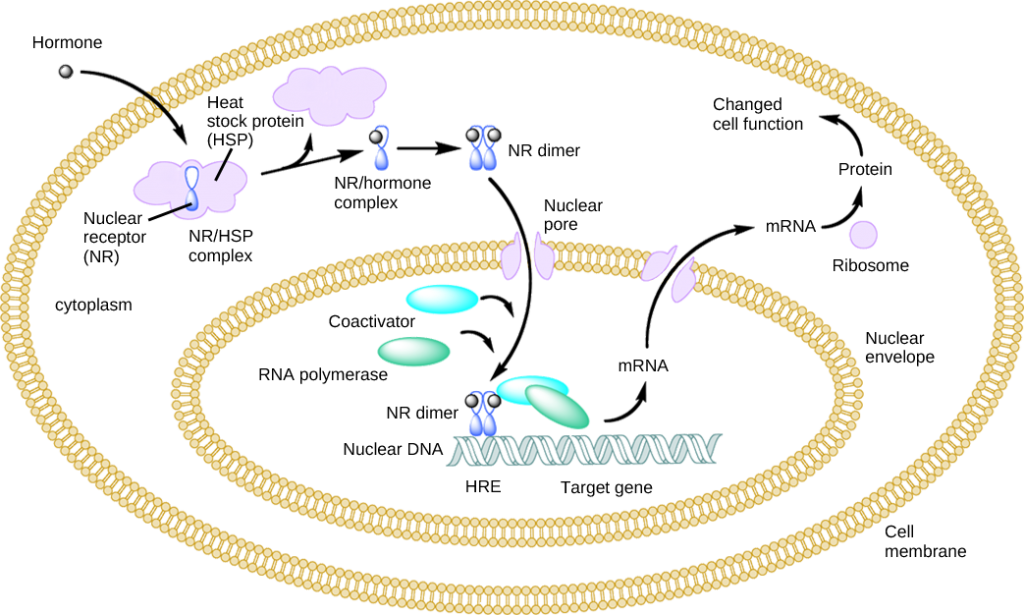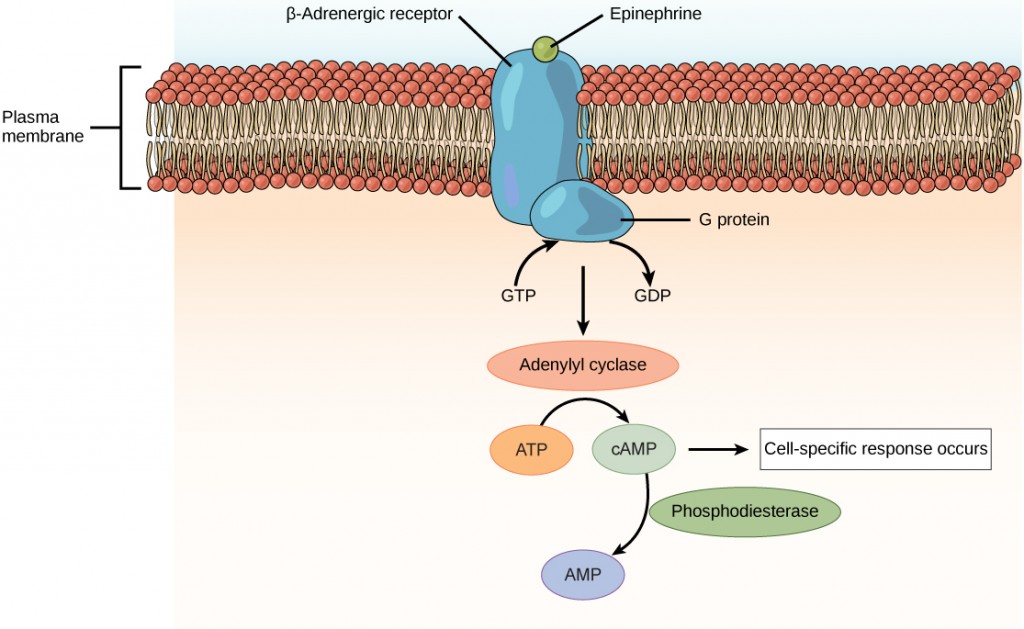What Hormone Affects The Changes Shown In This Flow Diagram?
Chapter 18. The Endocrine System
18.2 How Hormones Piece of work
Learning Objectives
Past the stop of this section, you lot will be able to:
- Explain how hormones work
- Discuss the office of different types of hormone receptors
Hormones mediate changes in target cells by binding to specific hormone receptors. In this mode, even though hormones broadcast throughout the body and come into contact with many different cell types, they simply touch cells that possess the necessary receptors. Receptors for a specific hormone may be constitute on many different cells or may be express to a small number of specialized cells. For case, thyroid hormones human action on many different tissue types, stimulating metabolic action throughout the body. Cells can have many receptors for the same hormone only oft also possess receptors for different types of hormones. The number of receptors that reply to a hormone determines the cell'southward sensitivity to that hormone, and the resulting cellular response. Additionally, the number of receptors that respond to a hormone can modify over fourth dimension, resulting in increased or decreased prison cell sensitivity. In up-regulation, the number of receptors increases in response to ascension hormone levels, making the cell more than sensitive to the hormone and allowing for more cellular activeness. When the number of receptors decreases in response to rising hormone levels, called downwards-regulation, cellular activity is reduced.
Receptor binding alters cellular activity and results in an increase or subtract in normal body processes. Depending on the location of the protein receptor on the target cell and the chemical structure of the hormone, hormones can mediate changes directly by binding to intracellular hormone receptors and modulating gene transcription, or indirectly past binding to prison cell surface receptors and stimulating signaling pathways.
Intracellular Hormone Receptors
Lipid-derived (soluble) hormones such as steroid hormones lengthened across the membranes of the endocrine cell. Once outside the cell, they bind to ship proteins that go on them soluble in the bloodstream. At the target prison cell, the hormones are released from the carrier protein and diffuse across the lipid bilayer of the plasma membrane of cells. The steroid hormones pass through the plasma membrane of a target prison cell and adhere to intracellular receptors residing in the cytoplasm or in the nucleus. The cell signaling pathways induced by the steroid hormones regulate specific genes on the cell'southward DNA. The hormones and receptor complex act every bit transcription regulators by increasing or decreasing the synthesis of mRNA molecules of specific genes. This, in plow, determines the amount of corresponding protein that is synthesized by altering gene expression. This poly peptide tin can be used either to change the structure of the jail cell or to produce enzymes that catalyze chemic reactions. In this style, the steroid hormone regulates specific cell processes as illustrated in Effigy xviii.5.

Rut shock proteins (HSP) are then named because they help refold misfolded proteins. In response to increased temperature (a "rut daze"), oestrus shock proteins are activated by release from the NR/HSP complex. At the aforementioned time, transcription of HSP genes is activated. Why practice you retrieve the prison cell responds to a heat shock by increasing the activeness of proteins that aid refold misfolded proteins?
Other lipid-soluble hormones that are not steroid hormones, such as vitamin D and thyroxine, take receptors located in the nucleus. The hormones lengthened across both the plasma membrane and the nuclear envelope, then demark to receptors in the nucleus. The hormone-receptor complex stimulates transcription of specific genes.
Plasma Membrane Hormone Receptors
Amino acid derived hormones and polypeptide hormones are not lipid-derived (lipid-soluble) and therefore cannot diffuse through the plasma membrane of cells. Lipid insoluble hormones bind to receptors on the outer surface of the plasma membrane, via plasma membrane hormone receptors. Dissimilar steroid hormones, lipid insoluble hormones exercise non directly affect the target cell because they cannot enter the prison cell and deed directly on Deoxyribonucleic acid. Binding of these hormones to a cell surface receptor results in activation of a signaling pathway; this triggers intracellular activity and carries out the specific effects associated with the hormone. In this way, nothing passes through the cell membrane; the hormone that binds at the surface remains at the surface of the cell while the intracellular product remains inside the cell. The hormone that initiates the signaling pathway is called a first messenger, which activates a second messenger in the cytoplasm, as illustrated in Effigy xviii.6.

One very important second messenger is circadian AMP (cAMP). When a hormone binds to its membrane receptor, a G-poly peptide that is associated with the receptor is activated; Yard-proteins are proteins split up from receptors that are plant in the cell membrane. When a hormone is not bound to the receptor, the G-poly peptide is inactive and is bound to guanosine diphosphate, or Gross domestic product. When a hormone binds to the receptor, the Thousand-protein is activated by binding guanosine triphosphate, or GTP, in identify of Gross domestic product. After binding, GTP is hydrolysed past the G-protein into GDP and becomes inactive.
The activated G-poly peptide in turn activates a membrane-bound enzyme called adenylyl cyclase. Adenylyl cyclase catalyzes the conversion of ATP to camp. cAMP, in plow, activates a grouping of proteins chosen poly peptide kinases, which transfer a phosphate grouping from ATP to a substrate molecule in a process called phosphorylation. The phosphorylation of a substrate molecule changes its structural orientation, thereby activating it. These activated molecules can so mediate changes in cellular processes.
The consequence of a hormone is amplified every bit the signaling pathway progresses. The binding of a hormone at a unmarried receptor causes the activation of many G-proteins, which activates adenylyl cyclase. Each molecule of adenylyl cyclase then triggers the formation of many molecules of cAMP. Further distension occurs as protein kinases, once activated by cAMP, can catalyze many reactions. In this way, a pocket-sized corporeality of hormone can trigger the germination of a large amount of cellular product. To finish hormone activity, campsite is deactivated past the cytoplasmic enzyme phosphodiesterase, or PDE. PDE is ever present in the jail cell and breaks down army camp to control hormone activity, preventing overproduction of cellular products.
The specific response of a cell to a lipid insoluble hormone depends on the type of receptors that are nowadays on the prison cell membrane and the substrate molecules present in the jail cell cytoplasm. Cellular responses to hormone binding of a receptor include altering membrane permeability and metabolic pathways, stimulating synthesis of proteins and enzymes, and activating hormone release.
Summary
Hormones cause cellular changes by bounden to receptors on target cells. The number of receptors on a target cell can increase or decrease in response to hormone activeness. Hormones can affect cells directly through intracellular hormone receptors or indirectly through plasma membrane hormone receptors.
Lipid-derived (soluble) hormones can enter the cell past diffusing across the plasma membrane and binding to DNA to regulate gene transcription and to change the prison cell's activities by inducing production of proteins that touch on, in general, the long-term structure and part of the prison cell. Lipid insoluble hormones bind to receptors on the plasma membrane surface and trigger a signaling pathway to change the cell'due south activities by inducing product of various cell products that impact the cell in the short-term. The hormone is called a outset messenger and the cellular component is chosen a 2nd messenger. Yard-proteins actuate the second messenger (cyclic AMP), triggering the cellular response. Response to hormone binding is amplified every bit the signaling pathway progresses. Cellular responses to hormones include the product of proteins and enzymes and altered membrane permeability.
Exercises
- A new antagonist molecule has been discovered that binds to and blocks plasma membrane receptors. What effect will this antagonist accept on testosterone, a steroid hormone?
- Information technology volition block testosterone from binding to its receptor.
- It volition block testosterone from activating camp signaling.
- It will increase testosterone-mediated signaling.
- It will not affect testosterone-mediated signaling.
- What consequence volition a cAMP inhibitor accept on a peptide hormone-mediated signaling pathway?
- Information technology will preclude the hormone from bounden its receptor.
- It will forbid activation of a G-protein.
- Information technology will prevent activation of adenylate cyclase.
- Information technology volition foreclose activation of protein kinases.
- Name two important functions of hormone receptors.
- How can hormones mediate changes?
Answers
- D
- D
- The number of receptors that respond to a hormone can alter, resulting in increased or decreased cell sensitivity. The number of receptors can increase in response to rising hormone levels, called up-regulation, making the jail cell more sensitive to the hormone and assuasive for more than cellular activeness. The number of receptors can also subtract in response to rising hormone levels, chosen down-regulation, leading to reduced cellular activity.
- Depending on the location of the protein receptor on the target cell and the chemical structure of the hormone, hormones can mediate changes directly by binding to intracellular receptors and modulating cistron transcription, or indirectly by binding to cell surface receptors and stimulating signaling pathways.
Glossary
- adenylate cyclase
- an enzyme that catalyzes the conversion of ATP to cyclic AMP
- down-regulation
- a decrease in the number of hormone receptors in response to increased hormone levels
- outset messenger
- the hormone that binds to a plasma membrane hormone receptor to trigger a signal transduction pathway
- G-protein
- a membrane protein activated past the hormone kickoff messenger to activate formation of cyclic AMP
- hormone receptor
- the cellular protein that binds to a hormone
- intracellular hormone receptor
- a hormone receptor in the cytoplasm or nucleus of a prison cell
- phosphodiesterase (PDE)
- enzyme that deactivates camp, stopping hormone activity
- plasma membrane hormone receptor
- a hormone receptor on the surface of the plasma membrane of a cell
- up-regulation
- an increment in the number of hormone receptors in response to increased hormone levels
Source: https://opentextbc.ca/biology/chapter/18-2-how-hormones-work/
Posted by: garberherrinfold.blogspot.com





0 Response to "What Hormone Affects The Changes Shown In This Flow Diagram?"
Post a Comment